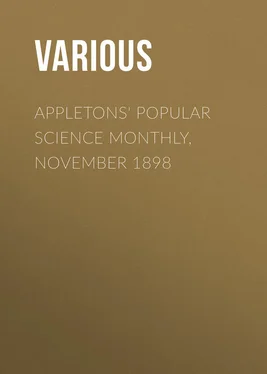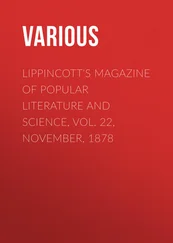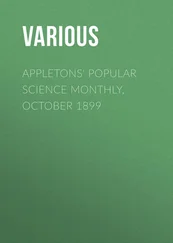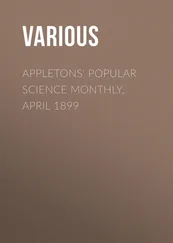Various - Appletons' Popular Science Monthly, November 1898
Здесь есть возможность читать онлайн «Various - Appletons' Popular Science Monthly, November 1898» — ознакомительный отрывок электронной книги совершенно бесплатно, а после прочтения отрывка купить полную версию. В некоторых случаях можно слушать аудио, скачать через торрент в формате fb2 и присутствует краткое содержание. Издательство: Иностранный паблик, Жанр: periodic, foreign_edu, на английском языке. Описание произведения, (предисловие) а так же отзывы посетителей доступны на портале библиотеки ЛибКат.
- Название:Appletons' Popular Science Monthly, November 1898
- Автор:
- Издательство:Иностранный паблик
- Жанр:
- Год:неизвестен
- ISBN:нет данных
- Рейтинг книги:5 / 5. Голосов: 1
-
Избранное:Добавить в избранное
- Отзывы:
-
Ваша оценка:
- 100
- 1
- 2
- 3
- 4
- 5
Appletons' Popular Science Monthly, November 1898: краткое содержание, описание и аннотация
Предлагаем к чтению аннотацию, описание, краткое содержание или предисловие (зависит от того, что написал сам автор книги «Appletons' Popular Science Monthly, November 1898»). Если вы не нашли необходимую информацию о книге — напишите в комментариях, мы постараемся отыскать её.
Appletons' Popular Science Monthly, November 1898 — читать онлайн ознакомительный отрывок
Ниже представлен текст книги, разбитый по страницам. Система сохранения места последней прочитанной страницы, позволяет с удобством читать онлайн бесплатно книгу «Appletons' Popular Science Monthly, November 1898», без необходимости каждый раз заново искать на чём Вы остановились. Поставьте закладку, и сможете в любой момент перейти на страницу, на которой закончили чтение.
Интервал:
Закладка:
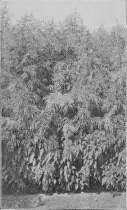
California Hemp.
This brings up an important point and presents another obstacle, for great harm has been done to all new fiber industries in recent years by the misdirected efforts of some professional promoters. In certain instances the organized fiber companies have been mere stock-jobbing concerns. They have had their rise and fall, men with idle money have burned their fingers, and the particular industry has received a "black eye."
The story of Government effort toward the establishment of the flax industry need not be told here; there has been widespread prejudice to overcome, with the opposition of the importers, discouragements to be studied and explained, the unvarnished truth to be told, and practical and authoritative information to be given to all who may seek it. The literature of the subject has been disseminated by thousands of copies, and new editions are being ordered.
As to the results: Superior flax has been produced in this country in limited quantities since the work began, and through extended field experiments flax regions have been discovered that are thought to equal the best flax centers of Europe. The department experiments in the Puget Sound region of Washington have demonstrated that we possess in that State a climate and soil that bid fair to rival the celebrated flax region of Courtrai, and from these experiments scutched flax has been produced that is valued by manufacturers in Ireland at three hundred and fifty dollars per ton, and hackled flax worth five hundred dollars per ton. Much has been done, but a great deal more remains to be accomplished in bringing together the farmer and capitalist in the practical work of growing, retting, scutching, and preparing for market American flax fiber, for questions of culture are settled.
Spreading Hemp in Kentucky.
We should restore our hemp industry to its former proportions by producing high-grade instead of low-grade fiber. The growth of a grade of American hemp that will sell for six to eight cents per pound, instead of three to three and a half cents per pound, as at the present time, means that our farmers must follow more closely the careful practices of Europe, and especially that they must adopt water retting in place of the present practice of dew retting, which gives a fiber dark in color and uneven in quality. A careful consideration of the practices of Italy and France as set forth in Fiber Report No. 11, Department of Agriculture, will materially aid those who desire to change their product from the cheaper dark hemps, for which there is small demand, to the higher-priced light hemps, which will compete with the imported commodity.
One of the most interesting problems of the day in the utilization of the new fiber material, and one that is attracting the attention of all civilized countries, is the industrial production of that wonderful substance known in the Orient as China grass, in India as rhea, and in Europe and America as ramie. The money spent by governments and by private enterprise throughout the world, in experiments and inventions, in the effort to establish the ramie industry, would make up the total of a princely fortune. Obstacle after obstacle has been overcome in the years of persistent effort, and now we stand before the last barrier, baffled for the time, but still hopeful, and with efforts unrelaxed. The difficulty may be stated in a few words: ramie culture will only become a paying industry when an economically successful machine for stripping the fiber has been placed on the market. Hundreds of thousands of dollars have been spent in efforts to perfect a machine, but no Government fiber expert in the world recognizes that we have such a machine at the present time, though great progress has been made in machine construction.
The world's interest in this fiber began in 1869, when a reward of five thousand pounds was offered by the Government of India for the best machine with which to decorticate the green stalks. The first exhibition and trial of machines took place in 1872, resulting in utter failure. The reward was again offered, and in 1879 a second official trial was held, at which ten machines competed, though none filled the requirements, and subsequently the offer was withdrawn. The immediate result was to stimulate invention in many countries, and from 1869 to the present time inventors have been untiring in their efforts to produce a successful machine. The commercial history of ramie, therefore, does not extend further back than 1869.
The first French official trials took place in 1888, followed by the trials of 1889, in Paris, at which the writer was present, and which are recorded in the official reports of the Fiber Investigation series. Another trial was held in 1891, and in the same year the first official trials in America took place, in the State of Vera Cruz, in Mexico, followed the next year by the official trials of American machines in the United States, these being followed by the trials of 1894. Since that year further progress in machine construction has been made, and a third official trial should be held in the near future.
Growth of Jute in Louisiana.
The first records of Chinese shipments of this fiber to European markets show that in 1872 two hundred or three hundred tons of the fiber were sent to London, valued at eighty pounds per ton, or about four hundred dollars. India also sent small shipments, but there was a light demand, with a considerable reduction in price, the quotations being thirty pounds to forty pounds per ton for Chinese and ten pounds to thirty pounds for the Indian product.
Those who are unacquainted with the properties and uses of this wonderful textile may peruse with interest the following paragraph from Fiber Report 7, on the Cultivation of Ramie, issued by the Department of Agriculture:
"The fiber of ramie is strong and durable, is of all fibers least affected by moisture, and from these characteristics must take first rank in value as a textile substance. It has three times the strength of Russian hemp, while its filaments can be separated almost to the fineness of silk. In manufacture it has been spun on various forms of textile machinery, also used in connection with cotton, wool, and silk, and can be employed as a substitute in certain forms of manufacture for all these textiles and for flax also, where elasticity is not essential. It likewise produces superior paper, the fineness and close texture of its pulp making it a most valuable bank-note paper. In England, France, Germany, Austria, and in our own country to an experimental extent, the fiber has also been woven into a great variety of fabrics, covering the widest range of uses, such as lace, lace curtains, handkerchiefs, cloth, or white goods resembling fine linen, dress goods, napkins, table damask, table covers, bedspreads, drapery for curtains or lambrequins, plush, and even carpets and fabrics suitable for clothing. The fiber can be dyed in all desirable shades or colors, some examples having the luster and brilliancy of silk. In China and Japan the fiber is extracted by hand labor; it is not only manufactured into cordage, fish lines, nets, and similar coarse manufactures, but woven into the finest and most beautiful of fabrics."
China is at present the source of supply of the raw product, and the world's demand is only about ten thousand tons, nine tenths of this quantity being absorbed in Oriental countries. The ramie situation in the United States at the present time may be briefly summarized as follows:
The plant can be grown successfully in California and in the Gulf States, and will produce from two to four crops per year without replanting, giving from two hundred and fifty to eight hundred pounds of fiber per acre, dependent upon the number of cuttings, worth perhaps four cents per pound. The machines for preparing this fiber for market are hardly able at the present time to clean the product of one acre (single crop) in a day, and the fiber is quite inferior to the commercial China grass. A new French machine produces a quality of fiber which approaches the China grass of commerce, but its output per day is too small to make its use profitable in this country. All obstacles in chemical treatment of the fiber and in spinning and manufacture are overcome, and the world is waiting for the successful device which will economically prepare the raw material for market.
Читать дальшеИнтервал:
Закладка:
Похожие книги на «Appletons' Popular Science Monthly, November 1898»
Представляем Вашему вниманию похожие книги на «Appletons' Popular Science Monthly, November 1898» списком для выбора. Мы отобрали схожую по названию и смыслу литературу в надежде предоставить читателям больше вариантов отыскать новые, интересные, ещё непрочитанные произведения.
Обсуждение, отзывы о книге «Appletons' Popular Science Monthly, November 1898» и просто собственные мнения читателей. Оставьте ваши комментарии, напишите, что Вы думаете о произведении, его смысле или главных героях. Укажите что конкретно понравилось, а что нет, и почему Вы так считаете.
